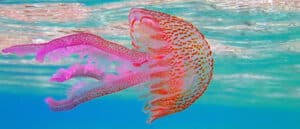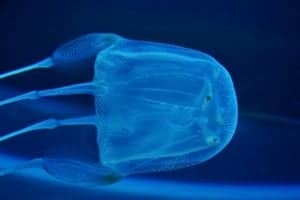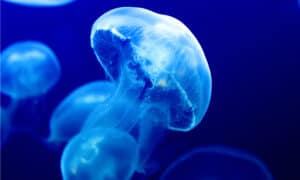Ask any person on the street, and they can probably describe a jellyfish to you. But do you know how long a jellyfish lives, or what their life cycle looks like? Jellyfish were swimming in our oceans before the dinosaurs walked the land, and some of them live a surprisingly long time. Here we’ll discover just how long jellyfish live, and why scientists have dubbed one species ‘The Immortal Jellyfish’.
Just What is a Jellyfish?

Jellyfish are a type of plankton rather than a fish.
©Martin Prochazkacz/Shutterstock.com
Jellyfish aren’t fish at all, they’re actually a type of plankton. They’re characterized by gelatinous, bell-shaped bodies with long tentacles that drift below them to catch food and warn off potential attackers. Even though they don’t have brains, jellyfish are actually the oldest multicellular creatures on earth, older than even the dinosaurs!
Jellyfish bodies are 95% water, and they range in size from smaller than the head of a pin to as long as a blue whale. The moon jellyfish (Aurelia aurita) is the most common type of jellyfish and is often seen in aquariums. Some people even keep jellyfish as pets, and others, particularly in Asian countries, consider them delicacies.
Jellyfish Lifespan
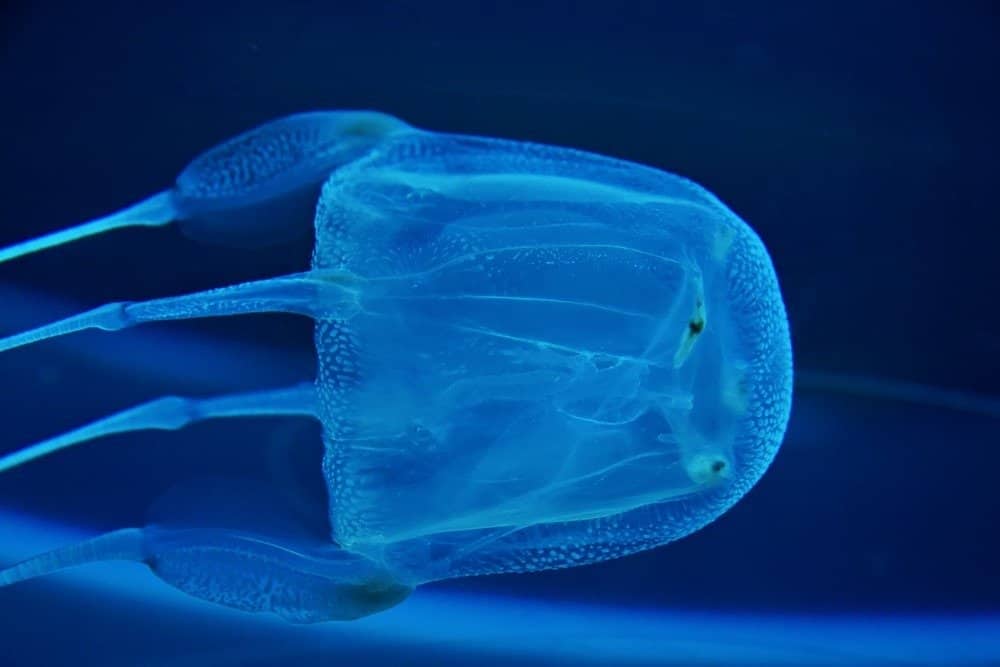
Most jellyfish live one to three years, but certain species can live from days to decades.
©Daleen Loest/Shutterstock.com
Jellyfish have complex life cycles, beginning with fertilized larvae floating in the ocean. The larvae sink and attach to the seabed or coral reefs, from there they develop into ‘polyps’. These polyps grow until they reach maturity, then detach from the seabed and float off into the ocean to feed and reproduce. These adult jellyfish are known as ‘medusas’.
Because of their complex life cycles, it’s difficult for scientists to say unequivocally how long jellyfish live. Domestic jellyfish live anywhere from one to three years. Wild species can live anywhere from a few days to decades.
One species in particular, dubbed the ‘Immortal Jellyfish’ (Turritopsis dohrnii) may actually live forever. This jellyfish is more likely to die at the hands (or mouth) of a turtle or fish than from old age.
The Oldest Jellyfish Ever: The Immortal Jellyfish
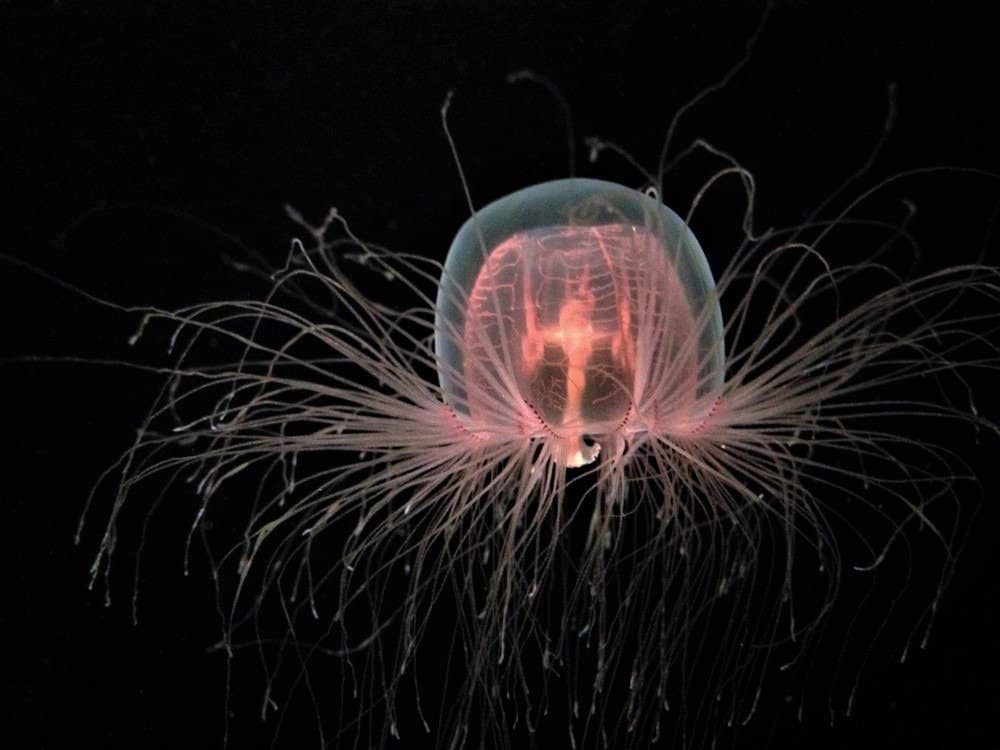
Immortal jellyfish are biologically immortal and thus the oldest jellyfish ever.
©Rebecca Schreiner/Shutterstock.com
Though there is no official ‘oldest jellyfish ever’, there is a very special species of jellyfish that scientists say may be immortal – biologically at least.
Turritopsis dohrnii, dubbed ‘the immortal jellyfish’ may be the oldest living creature on the planet. When this jellyfish gets old, hurt, or even too hungry, it uses a process called ‘transdifferentiation’ to regenerate its old cells.
First, the jellyfish falls to the ocean floor or coral reef. From there the adult medusa reverts back to its polyp form, regenerating the cells and creating brand new, youthful cells that are genetically identical to the old medusa. The immortal jellyfish can theoretically do this forever, that is until it gets eaten by some other sea creature like a turtle, whale, or fish. Scientists think that unhindered, the immortal jellyfish can keep on living forever, with no cap on the number of times it can regenerate.
The Jellyfish Life Cycle in Five Steps

Jellyfish have a very different lifecycle than humans.
©iStock.com/vojce
Jellyfish go through life in several different forms. Most jellyfish only go through these steps once before dying, but the immortal jellyfish repeats them over and over again — potentially forever.
- Fertilized Egg: Jellyfish begin life as fertilized eggs. Adult female jellyfish release their eggs into the ocean, while adult male jellyfish release sperm. Ocean currents bring the two together to create a fertilized egg.
- Planula: The fertilized egg floats along in the water and develops into a planula — an oval-shaped jellyfish egg with tiny cilia (hair-like appendages) that propel it through the water until it finds a hard surface to attach to.
- Polyp: Once attached to a hard surface like the ocean floor or a coral reef, the egg develops into a polyp (think of a sea anemone). The polyp grows bigger and bigger until it resembles a stack of polyps ready to split off one by one.
- Ephyra: Once the polyp is ready, it begins to split off, one stack at a time. Each piece that comes off is called an ephyra. The ephyra are now free-floating in the ocean and resemble flattened-out adult jellyfish.
- Adult Medusa: Once the ephyra are fully developed, they are known as medusa, and look like what we would all think of when we think of a jellyfish. From here the life cycle repeats.
Conservation
The jellyfish is one of the very few species that doesn’t seem to have been negatively impacted by climate change and human interference. As far as scientists can tell, jellyfish populations have actually increased in recent decades.
One type of endangered jellyfish is the freshwater jellyfish. Native to China, and no bigger than a penny, this jellyfish lives exclusively in fresh (not salt) water and has been on the decline in China due to water pollution. However, freshwater jellyfish can be found all over the world in sources of freshwater like lakes, reservoirs, and rivers.
Can Jellyfish Feel Pain?
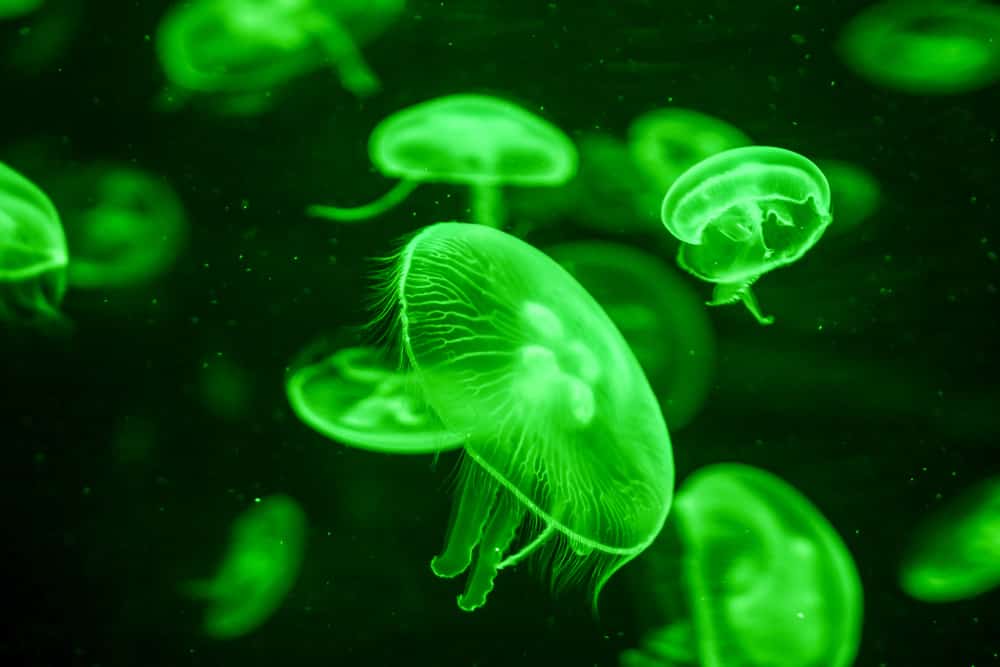
©underworld/Shutterstock.com
Jellyfish are comprised of 95% water and unlike humans, jellyfish do not possess true brains, bones, hearts, or a respiratory system. As a result, they do not feel pain in the same way. They have a basic network of neurons that allows them to feel their environment. This basic network of responses only enables them to react to a limited number of stimuli. While they can sense certain painful stimuli, they do not feel when there is damage done to their bodies.
It is believed that as they do not possess a true brain, they have no conscious behavior although they are capable of certain feelings as they are known to respond to their environments, specifically reacting to potential danger, which is when they exhibit a flight response. They are also known to get stressed, specifically when they are handled roughly.
The photo featured at the top of this post is © Fon Duangkamon/Shutterstock.com
Thank you for reading! Have some feedback for us? Contact the AZ Animals editorial team.



